

|
Soundclip:
|
| See Steve's Hand-Written Solo
Transcription |
|
Grant Green's solo on: "Red River Valley"(James Kerrigan) I remember when I bought Grant Green's "GOIN' WEST"(Blue Note) album in 1969, my last year at U.C.L.A.! I remember seeing all those familiar "Western" song titles that I had been familiar with since I was in grammar school in West Los Angeles. I thought that this was such a cool idea for a Jazz guy to be playing those tunes. Of course, at the time, I had already owned Sonny Rollins' "WAY OUT WEST" album from 1957. I was under the impression that all the wonderful albums and music coming from Blue Note, Riverside, Verve, ¡mpulse, Columbia, Atlantic, RCA, and other record labels were all released within 6-9 months after they had been recorded. Over the years that have come and gone, I have learned that this perception was completely false. 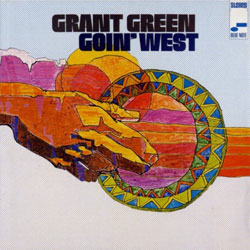 Before writing this piece, I did some research and learned that "GOIN' WEST" had actually been recorded in November of 1962!!! Imagine my surprise! As a Grant Green fan, what was so striking about this "new" information was that "THE LATIN BIT," one of my all-time favorite albums of his had been recorded in September of 1962 and released in early 1963. I didn't realize that labels used to record various artists and then, for reasons of their own, just sat on them, sometimes for years. But, more about this later, I promise. Before writing this piece, I did some research and learned that "GOIN' WEST" had actually been recorded in November of 1962!!! Imagine my surprise! As a Grant Green fan, what was so striking about this "new" information was that "THE LATIN BIT," one of my all-time favorite albums of his had been recorded in September of 1962 and released in early 1963. I didn't realize that labels used to record various artists and then, for reasons of their own, just sat on them, sometimes for years. But, more about this later, I promise.The fantastic personnel for this album consisted of: Herbie Hancock(Piano); Reggie Workman(Ac. Bass); and Billy Higgins(Drums), and I listened as if Herbie's playing was coming from a place after his tenure with Miles Davis and even many of his own incredible Blue Note albums. But that perception was completely false. As it turns out, Herbie was to join the Miles Davis Quintet the following year, but he had already recorded his first album for Blue Note, "TAKIN' OFF" earlier in 1962. Anyway, "GOIN' WEST" included some very creative choices of songs including: "On Top of Old Smokey"; "Tumblin' Tumbleweeds"; and "Wagon Wheels" - all songs that I love. In addition to those tunes, the one that always stayed with me was the wonderful interpretation of "Red River Valley" which I remember having to sing in grammar school as part of a class, or a choir. It's interesting that the song consists of two stanzas which fall into a 16-bar repeating form. There is no traditional 'bridge' at all. If you are interested, here are the lyrics: We will miss your bright eyes and sweet smile For they say you are taking the sunshine That has brightened our pathway a while. So come sit by my side if you love me Do not hasten to bid me adieu Just remember the Red River Valley And the cowboy that has loved you so true A 16-bar format for improvising has served the Jazz world well. for example, three tunes that I always loved to play were: "On the Trail" and the Brazilian tune, "Little Boat"(O Barquinho) and Tadd Dameron's "Lady Bird." But, how could we forget John Coltrane's "Giant Steps and "Countdown"; or Sonny Rollins' "Pent-Up House" and Wayne Shorter's "Night Dreamer." So the form of "Red River Valley" places it right in that company, if not of the same depth in some cases. But, the truth is that, "Red River Valley" is rarely, if ever, played by Jazz musicians, young or old! Grant Green plays a most characteristic and diatonic pick-up into Chorus 1 and, generally speaking, he is playing from within the approach of viewing the first 4 bars as being within the key of Ab major, and staying within the Ab major scale [Ab, Bb, C, Db, Eb, F, G]. Though you could say that, in bar 2, he is observing the Bbm7 chord with a similar simple arpeggio. But, that aside, sometimes it is best to take the long view and see that he is playing very melodically through those 4 bars, changes or not. As the I-VI7-ii-V approaches for bars 5-8, at the end of bar 4, he plays a pick-up to Abmaj7 that has much more of a Jazz flavor to it because of the triplet grouping on beat 3 and the chromatic passing tone from F-E-Eb. In bar 5, at the end of the bar there is another classic Jazz phrasing technique as he glisses down with a 16th-note triplet figure into F7(alt.), that keys a descending line that lands on the most pivotal note for covering this chord change, A-natural. 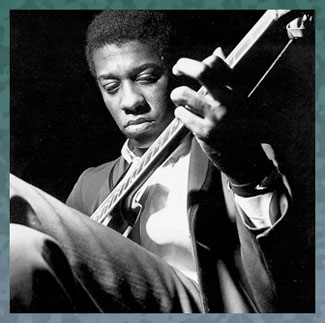 As Bbm7 approaches in bar 7, the pick-up passes through the b9(Gb) on its way to landing on the m3rd(Db) of the coming chord. Then as the V7 chord, Eb7(alt.) approaches, he plays another descending triplet gliss into the bar that passes through both the #9(Gb) and the b9(Fb), landing on the root(Eb) on beat 1. Again, the true target note of all of this is to hit the G-natural(maj3rd) on beat 3. From there, he vaults through an Eb7b9 arpeggio and back down to land on a C-natural, as a ii-V to the IVmaj7(Dbmaj7) begins in bars 9-12. In bar 9, as bassist Reggie Workman is playing Ab's and Eb's, it gives Herbie Hancock's chords a more suspended feeling, as during bars 9-11, Green is again playing very diatonically in Db major, using notes from the Db major scale [Db, Eb, F, Gb, Ab, Bb, C]. In bar 12, as the chord change moves to Dbm7, he is using notes that come from Db Dorian [Db, Eb, Fb, Gb, Ab, Bb, Cb]. There are several ways to treat bars 11-12 from a chordal perspective. You could play, as they do here: [1] Dbmaj7 to Dbm7; [2] Dbmaj7 to Dbm7-Gb7; or you could play [3] Dbmaj7 to Gb7(13). All those choices will sound great and, in truth, no one of them is necessarily more common or standard than any other. For phrasing pay attention to the triplet arpeggios that appear on beat 1 of both bars 10 and 12. In bars 13-16, as the chords are played as two 2-bar turnarounds in Ab major, Green returns to playing very diatonically and melodically through all of them. The only chromatic notes that appear in those bars is a lower neighbor(B-natural) to C-natural in bar 14 and a passing tone(D-natural) between Eb and Db. There is also one little guitar phrasing mannerism that is very particular to Grant Green and that is the hammer-on from C up to Eb on beat 3 of bar 15. If you are trying to immerse yourself in his wonderful style, this is something he has always done throughout his career. The other thing that you might notice, and I can't say that I would recommend it, is that he plays many of his 8th-notes in a very quasi-staccato manner. Normally I would advice players, young and old, to get more duration out of their notes. But, in this case, it is truly a part of Green's style and one must respect it. As Bbm7 approaches in bar 7, the pick-up passes through the b9(Gb) on its way to landing on the m3rd(Db) of the coming chord. Then as the V7 chord, Eb7(alt.) approaches, he plays another descending triplet gliss into the bar that passes through both the #9(Gb) and the b9(Fb), landing on the root(Eb) on beat 1. Again, the true target note of all of this is to hit the G-natural(maj3rd) on beat 3. From there, he vaults through an Eb7b9 arpeggio and back down to land on a C-natural, as a ii-V to the IVmaj7(Dbmaj7) begins in bars 9-12. In bar 9, as bassist Reggie Workman is playing Ab's and Eb's, it gives Herbie Hancock's chords a more suspended feeling, as during bars 9-11, Green is again playing very diatonically in Db major, using notes from the Db major scale [Db, Eb, F, Gb, Ab, Bb, C]. In bar 12, as the chord change moves to Dbm7, he is using notes that come from Db Dorian [Db, Eb, Fb, Gb, Ab, Bb, Cb]. There are several ways to treat bars 11-12 from a chordal perspective. You could play, as they do here: [1] Dbmaj7 to Dbm7; [2] Dbmaj7 to Dbm7-Gb7; or you could play [3] Dbmaj7 to Gb7(13). All those choices will sound great and, in truth, no one of them is necessarily more common or standard than any other. For phrasing pay attention to the triplet arpeggios that appear on beat 1 of both bars 10 and 12. In bars 13-16, as the chords are played as two 2-bar turnarounds in Ab major, Green returns to playing very diatonically and melodically through all of them. The only chromatic notes that appear in those bars is a lower neighbor(B-natural) to C-natural in bar 14 and a passing tone(D-natural) between Eb and Db. There is also one little guitar phrasing mannerism that is very particular to Grant Green and that is the hammer-on from C up to Eb on beat 3 of bar 15. If you are trying to immerse yourself in his wonderful style, this is something he has always done throughout his career. The other thing that you might notice, and I can't say that I would recommend it, is that he plays many of his 8th-notes in a very quasi-staccato manner. Normally I would advice players, young and old, to get more duration out of their notes. But, in this case, it is truly a part of Green's style and one must respect it.As Chorus 2 begins Grant is still playing very melodically, this time with a theme of simple arpeggios, spelling out Ab major and Bbm7. The sense of being in or around Ab major continues through bar 5. But this time, in bar 6, he lines reveal an approach that is closer to hearing the chord as a vim7(Fm7) rather than F7(alt.). Again, this is a very diatonic approach to playing through changes, and there's nothing wrong with that. Over the Eb7(alt.) chord in bar 8, you hear the most Jazzy phrasing as he again passes through both #9(Gb) and b9(Fb) on his way to bar 9 and his approach to it as more Ab7 than Ebm7-Ab7-Dbmaj7. Over the course of bars 9-12, we are still in a Db major area, but, one could say that Green is playing in Eb Dorian [Eb, F, Gb, Ab, Bb, C, Db] through bars 9-10. But, in the end, these 3 possible modes: Db Ionian(Major); Eb Dorian; or Ab Mixolydian all contain the same notes as they are in the key area of Db major. So, it really just depends upon your own personal point of orientation, how you relate to chord changes. In bar 11, over the Dbmaj7 chord, he plays an Ab with a bluesy feel to it by glissing into the note from a 1/2-step below. That same Ab is restated in bar 12, and in bar 13, though it sounds like a "mistake" - I wrote Ab there too because I am certain that that was the note that he meant to play. All the triplet groupings that appear as he approaches Ab are really drawn from his blues language and the Ab blues scale [Ab, Cb, Db, D, Eb, Gb], and this continues through bar 15. In bar 16, he is playing a blues-oriented line through the ii-V to Abmaj7. This is, of course, a very common device amongst Jazz players who have their roots in the blues. So, even though there might be some notes that could be intellectually questioned as you pass through the modality of any ii-V, they sound and feel great, so your ears always have to be guide as to what you play. The first 2 bars of Chorus 3 begin almost exactly as bar 1-2 of the 2nd chorus began. The only difference is that, on bear 4 of bar 2, this time Green plays an Eb instead of a C. From the end of bar 3 through the downbeat of bar 7, his phrases are really filled with the classic language of Jazz. This language has more chromaticism, usually in the form of passing tones, that say just playing through the chord changes in a diatonic but most melodic manner. Once again, in bar 6, over the F7(alt.) chord, he makes a point of landing on A-natural on beat 3, just as he did in the 1st chorus, and again playing a Gb(b9) on the downbeat of beat 4. Then, in bar 7, he does another great Jazz linear device, as we are expecting that there will be Bbm7 in that bar, Grant Green plays a D-natural on beat 1 and then goes on to outline notes from Bb7(9) [D-F-Ab-C], even though Herbie Hancock clearly plays a Bbm7 voicing at the end of the bar. That aside, substituting the V7(Bb7) of V7(Eb7) is a most common trick that sophisticated players use. Of course, it is most effective when there is no accompaniment from another chordal instrument. In bar 8, he is clearly playing notes from Bb Dorian before landing on an Ab in bar 9 and riding that one note through bar 12, all played with a very bluesy feeling. At the end of that bar, it's really the 1st time that you hear him put to use the true blue note of Cb! Bar 14, contains what is, to me, a really classic Grant Green blues lick and I like how he concludes this idea in bar 15 by landing on an F-natural(6th) which is also very common to blues-related playing. The pick-up to Chorus 4 begins with another familiar Jazz device, that is quoting from another great Jazz standard with, perhaps, similar chord changes. Here, Green quotes Charlie Parker's "My Little Suede Shoes." What makes this all so amusing and even historical is that, just a few months earlier in 1962, Green had recorded "My Little Suede Shoes" for his own classic album, "THE LATIN BIT," playing the tune in the expected Eb major key. Here, as we know, he is now quoting from the main melody, but this time in Ab major, with the quote extending through the end of bar 8. 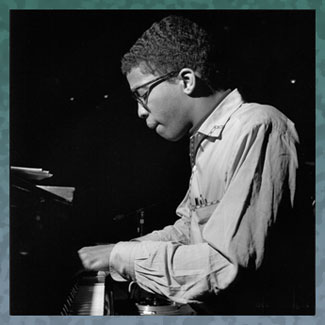 Finally, as he negotiates bars 9-12, he approaches bar 9 as an Ebm7(9) bar the line is derived from Eb Dorian [Eb, F, Gb, Ab, Bb, C, Db]. Then, this is followed immediately by approaching bar 10 as Ab7(alt.), and here his line comes from the Ab 1/2-tone whole-tone diminished scale [Ab, A, B, C, D, Eb, F, Gb]. For phrasing, pay attention to the little grouping of 3 16th-notes with an 8th-note on beat 1 of bar 12. Over the Dbmaj7 chord, though all of the notes are from Db major, he plays an F minor 7 arpeggio into a Db major 7 arpeggio. In bar 12, over a Dbm7 chord that is headed to cadence on Abmaj7, Grant is really playing through the bar with more of a bluesy sense of Ab minor pentatonic [Ab, Cb, Db, Eb, Gb] than any particular mode. He stays in a blues-related mood through bars 13-16, and especially with the repeated traditional blues lick from the end of bar 14 until the downbeat of the next chorus. Finally, as he negotiates bars 9-12, he approaches bar 9 as an Ebm7(9) bar the line is derived from Eb Dorian [Eb, F, Gb, Ab, Bb, C, Db]. Then, this is followed immediately by approaching bar 10 as Ab7(alt.), and here his line comes from the Ab 1/2-tone whole-tone diminished scale [Ab, A, B, C, D, Eb, F, Gb]. For phrasing, pay attention to the little grouping of 3 16th-notes with an 8th-note on beat 1 of bar 12. Over the Dbmaj7 chord, though all of the notes are from Db major, he plays an F minor 7 arpeggio into a Db major 7 arpeggio. In bar 12, over a Dbm7 chord that is headed to cadence on Abmaj7, Grant is really playing through the bar with more of a bluesy sense of Ab minor pentatonic [Ab, Cb, Db, Eb, Gb] than any particular mode. He stays in a blues-related mood through bars 13-16, and especially with the repeated traditional blues lick from the end of bar 14 until the downbeat of the next chorus.Bars 1-8 of Chorus 5 features lines that again reveal a sense of both playing within the area of Ab major, but also being closely tied to Grant Green's blues roots. For those elements, play close attention to bar 4 and bars 7-8. In bars 9-11, as the ii-V to Dbmaj7 arrives, he stays in the area of the Ab blues scale [Ab, Cb, Db, D, Eb, Gb], and that feeling and sense continues all the way through to the end of the chorus as he rides another very traditional blues lick, and one that is played on the guitar very much in the Grant Green style! This is really what one comes to expect from many Grant Green solos, and it is a huge part of his charm and appeal as a player. You should also notice that his particular tone is quite a bit brighter than another bluesy Jazz guitarist of the same period, the great Kenny Burrell. In the same way, Grant's tone is also brighter than Wes Montgomery and Jim Hall, the other two giants of those years. As Chorus 6 arrives, the final chorus of the solo, Grant continues with this bluesy attitude, but with very syncopated phrasing that recognizes the Brazilian feeling coming from Billy Higgins on the drums. Again, pay attention to Billy's cross-stick rhythms on his snare. On beat 4 of bar 4, the jazzier linear elements return, and, in a most wondrous way. This is, to my ears, the most Jazz-related part of the solo because of the configuration of the lines and where the chromaticism appears. Notice how, in bar 6, he acknowledges the arrival of the VI7 chord, F7(alt.) by hitting an A-natural, this time right on beat 1 of the bar. Then he ascends from there with an arpeggio that outlines F7(b9) leading towards Bbm7 in bar 7 and another arpeggio driven line for that sonority. Bar 8 over the moment of the most linear sophistication of the entire solo, as he is playing over an Eb7 chord that is on its way to turning into Ebm7 as it heads towards Dbmaj7. But, instead of attacking that Eb7 chord with notes from Bb Dorian, Green is playing 1/2-step above the chord to which he headed. So, for this singular moment in his solo, he is really approaching it as if there existed a b5 sub of Em7-A7. This approach would yield a mode of E Dorian [E, F#, G, A, B, C#, D]. Take a look at the notes in this bar and see what you think. Completely related to this moment, there is a great, great line early on in Herbie Hancock's solo where you can hear this same device, on this soundclip, it occurs at about 2:48 just before it fades out. You know that I made certain that this Herbie moment was included because it is my absolute favorite moment on the recording! In bar 9, Grant Green continues by playing an Ebm7 arpeggio before passing through another b5 sub, this time A7 [G-E-C#-A-G] before ascending via an Ab7 arpeggio into Db major lines. In bar 11, I love how he plays in Dbm7 before the chord arrives. Again, to me, this is coming from Db Dorian. The final 4 bars of the solo close out with another bluesy related ideas and, as he is riding the 4th(Db) through the turnaround in bars 15-16, the phrasing becomes most difficult to transcribe and notate accurately. So, as I often do, I just decided to write it out in a manner that represents more what I thought that he was trying to play, not what exactly came out at that moment. I hope that it makes sense to you all. My apologies if it doesn't. At this moment, as I sit here in October of 2016, I wanted to again acknowledge the passing of one of the greatest forces in Jazz history, the legendary recording engineer who recently passed away, Rudy Van Gelder, who, of course, recorded "GOIN' WEST" and countless other incredible Blue Note albums. He created a sound for that label, and other recognizable sounds for other Jazz labels as well. 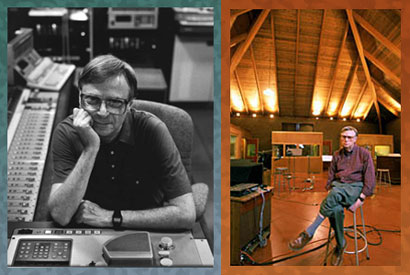 The photo on the right side of my little collage offers a nice view of the immense nature or Rudy's converted barn that became Van Gelder Studios in Englewood Cliffs, New Jersey. When I was younger, in college, and buying all these classic LPs, I never noticed the radical nature of Rudy's panning of the instruments in the stereo field. It's hard to believe that I couldn't tell that the drums were always panned HARD RIGHT, and usually the soloist, here Grant Green, was panned HARD LEFT. The acoustic bass and the acoustic piano were in the center. If you adjust the balance control on your stereo system or your computer moving it hard left or hard right, you might think that, for example, you hear some of Billy Higgins' drums on the left side, or some of Grant Green's guitar on the right side. In truth, you do, BUT, what you are hearing is really only room leakage because everyone, in those days was playing in one room with no isolation and probably little baffling as well. And yet, Rudy made it all work and sound wonderful. Rudy's loss was yet another very sad, sad day for the entire Jazz community. If you are at all interested, I sat down then and wrote an homage to him at the TRIBUTES page at the site to express how much his recordings and body of work had meant to me. When you arrive at that page, just scroll down and you see Rudy's photos. The photo on the right side of my little collage offers a nice view of the immense nature or Rudy's converted barn that became Van Gelder Studios in Englewood Cliffs, New Jersey. When I was younger, in college, and buying all these classic LPs, I never noticed the radical nature of Rudy's panning of the instruments in the stereo field. It's hard to believe that I couldn't tell that the drums were always panned HARD RIGHT, and usually the soloist, here Grant Green, was panned HARD LEFT. The acoustic bass and the acoustic piano were in the center. If you adjust the balance control on your stereo system or your computer moving it hard left or hard right, you might think that, for example, you hear some of Billy Higgins' drums on the left side, or some of Grant Green's guitar on the right side. In truth, you do, BUT, what you are hearing is really only room leakage because everyone, in those days was playing in one room with no isolation and probably little baffling as well. And yet, Rudy made it all work and sound wonderful. Rudy's loss was yet another very sad, sad day for the entire Jazz community. If you are at all interested, I sat down then and wrote an homage to him at the TRIBUTES page at the site to express how much his recordings and body of work had meant to me. When you arrive at that page, just scroll down and you see Rudy's photos."Red River Valley" marks the 2nd time that, at KORNER 1, we have shared a great solo by Grant Green. The first solo that we posted was his "Mambo Inn" solo from the aforementioned "THE LATIN BIT" album. It remains fascinating to me how, in some way, these to recordings bear some kind of connection to one another as they were actually recorded within the same calendar year, 1962, and yet, "THE LATIN BIT" was released in 1963, and "GOIN' WEST" just sat on the shelf for some 6 years, and was not released until 1969. And yet, to me, when I first bought the LP, it sounded like it could have been recorded recently. That's just how consistent the level of audio excellence was with anything that Rudy Van Gelder engineered. It's also amazing that, in the CD age, we have often been given bonus tracks that were recorded at the same time, but could not fit within the constraints of the LP format. Sometimes, those tracks add so much to our appreciation of the music, the playing of these great players, and our perceptions of those times, usually the '60s. I will hope that everyone who has visited this page has enjoyed this little insight into one of my favorite players, Grant Green! And, on another note entirely. Like most of the transcriptions you see at KORNER 1, "Red River Valley" 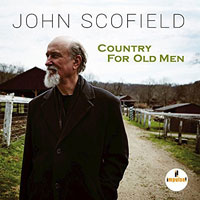 was done during the latter part of my college years at U.C.L.A.('65-'69), and then rewritten at some point during the past 15 years. Since then, it has been sitting around awaiting a glorious moment like this. As I was preparing the analysis, the text for this page, I happened to see that my old pal, John Scofield had just recorded this very song, as part of his "COUNTRY FOR OLD MEN"(impulse!) album, featuring: Larry Goldings; Steve Swallow; and Bill Stewart. Scofield's version states the melody à la Johnny and the Hurricanes' million seller single, "Red River Rock" from 1959. But, not to worry, the soloing is all performed in John's own hard-swinging and very personal style. Just for fun, you might want to compare and contrast his version with Grant Green's? Just sayin'!!! :-) By the way, did you know that, prior to John's very first gig in New York, as he was coming into town from Boston to play a concert with drummer Horacee Arnold, I lent him one of my small Fender Amps, probably my Fender Deluxe, for the gig? How 'bout that? We've been friends ever since!!! was done during the latter part of my college years at U.C.L.A.('65-'69), and then rewritten at some point during the past 15 years. Since then, it has been sitting around awaiting a glorious moment like this. As I was preparing the analysis, the text for this page, I happened to see that my old pal, John Scofield had just recorded this very song, as part of his "COUNTRY FOR OLD MEN"(impulse!) album, featuring: Larry Goldings; Steve Swallow; and Bill Stewart. Scofield's version states the melody à la Johnny and the Hurricanes' million seller single, "Red River Rock" from 1959. But, not to worry, the soloing is all performed in John's own hard-swinging and very personal style. Just for fun, you might want to compare and contrast his version with Grant Green's? Just sayin'!!! :-) By the way, did you know that, prior to John's very first gig in New York, as he was coming into town from Boston to play a concert with drummer Horacee Arnold, I lent him one of my small Fender Amps, probably my Fender Deluxe, for the gig? How 'bout that? We've been friends ever since!!!Here's hoping that everyone had a very happy and safe HALLOWEEN and, as we have now arrive at November, 2016, we certainly hope that everyone has a very warm, cozy, toasty, and HAPPY THANKSGIVING!!! Beyond those sentiments, I want to take this opportunity to wish everyone a very Joyous Holiday Season, and the best of everything in the coming year of 2016. I also want to take this opportunity to wish everyone a wonderful Autumn as the leaves turn to flame and the temperatures begin to hint at winter. Thanks again to everyone for their wonderful messages via the CONTACT STEVE page, as well as the supportive comments that appear in our GUESTBOOK.
[Photos of Grant Green and Herbie Hancock
by: Francis Wolff Rudy Van Gelder @ Van Gelder Studios, Englewood Cliffs, NJ] |